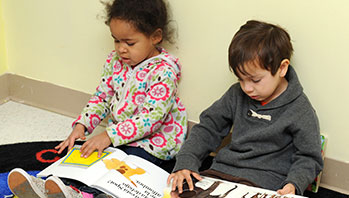-
fiction and nonfiction books (different topics and genres)
- author
- cover
- illustration
- title
MA Standards:
Foundational Skills/RF.PK.MA.1: With guidance and support, demonstrate understanding of the organization and basic features of printed and written text: books, words, letters, and the alphabet.
Foundational Skills/RF.PK.MA.1.a: Handle books respectfully and appropriately, holding them right-side-up and turning pages one at a time from front to back.
Speaking and Listening/SL.PK.MA.1: Participate in collaborative conversations with diverse partners during daily routines and play.
Head Start Outcomes:
Social Emotional Development/Social Relationships: The healthy relationships and interactions with adults and peers.
Approaches to Learning/Persistence and Attentiveness: The ability to begin and finish activities with persistence and attention.
Literacy Knowledge/Book Appreciation and Knowledge: The interest in books and their characteristics, and the ability to understand and get meaning from stories and information from books and other texts.
PreK Learning Guidelines:
English Language Arts/Language: Communicate personal experiences or interests.
Independent and Partner Reading, Unit 1, Week 2

© Commonwealth of Massachusetts, Department of Early Education and Care (Jennifer Waddell photographer). All rights reserved.
Educator Prep: If your room doesn’t already have a library, set up a Library Center that children can use with ease and which can be used throughout the year. Create book-browsing boxes using plastic bins or cardboard boxes. Label each box with words and a matching picture or symbol so children can identify the contents on their own. Include many different categories of books, such as books about animals, trucks, families, and so on. You may also want to create a wall display with snapshots of children “reading” books in the room. This will help children see themselves as readers and motivate them to learn the skills they will need to get ready to read.
Explain that the pictures on the labels will help children select the kind of book they want to read and also help them put the book away. Ask, If you wanted to read a book about bears, which box would you look in? Model for children by saying, This box has a picture of lots of animals on it, so I think this is where I will find books about animals.
Encourage children to select books that interest them and to look at the words and pictures on their own or with another child. Model how to read the title and author, to look at the illustration on a book cover, to predict what the book will be about, and then decide whether you want to read it. Go over basic library rules about how to handle and care for books. You may want to sing “This Is the Way We Hold Our Books” during your demonstration.
This Is the Way We Hold Our Books
(sung to the tune of “Lazy Mary”)
This is the way we hold our books,
Hold our books, hold our books.
This is the way we hold our books
When we are busy reading.
This is the way we open our books,
Open our books, open our books.
This is the way we open our books
When we are busy reading.
This is the way we turn a page,
Turn a page, turn a page.
This is the way we turn a page
When we are busy reading.
